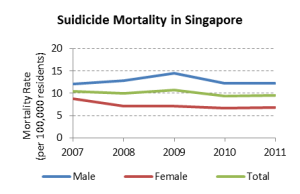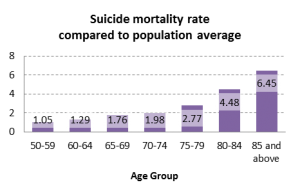-
Advocacy Theme
-
Tags
- Abortion
- Adoption
- Caregiving
- CEDAW
- Disability
- Domestic Violence
- Domestic Workers
- Harassment
- Healthcare
- Housing
- International/Regional Work
- Maintenance
- Media
- Migrant Spouses
- Migrant Workers
- Muslim Law
- National budget
- Parental Leave
- Parenthood
- Polygamy
- Population
- Race and religion
- Sexual Violence
- Sexuality Education
- Single Parents
- Social Support
- Sterilisation
- Women's Charter
Elderly suicides: An absence of hope and heart
September 12th, 2012 | News, Older People and Caregiving, Suicide, Views
As Singapore becomes increasingly affluent, we should not forget the individuals with a different kind of “high net worth” – our senior citizens, who have worked and built this country. Do they have a home with hope and heart in what is supposed to be their golden years?
By Vivienne Wee, Nadzirah Samsudin & Priyanka Bhandari
10 September marked the 10th annual World Suicide Prevention Day. According to the World Health Organization (WHO), approximately one million lives are lost to suicide every year worldwide; this is more than lives lost to homicide and war. About 5 per cent of people attempt suicide once in their lives, although the global mortality rate is only a fraction of that at 0.016 per cent (or 16 per 100,000).
However, a suicide attempt rate of 5 per cent is still too high, as it signals widespread depression and hopelessness. Suicide attempts are often a cry for help and it is tragic that people have to resort to this to obtain help.
World Suicide Prevention Day is an initiative of the International Association for Suicide Prevention (IASP), in collaboration with WHO. The theme they have chosen this year is “Suicide Prevention Across The Globe: Strengthening Protective Factors And Instilling Hope.”
This comes close to our very own message of “Hope, Heart and Home” in this year’s National Day Rally Speech.
As Singapore becomes increasingly affluent, we should not forget the individuals with a different kind of ‘high net worth’ – our senior citizens, who have worked and built this country. Do they have a home with hope and heart in what is supposed to be their golden years?
A worrying trend in Singapore is the higher prevalence of suicide mortality among the elderly, as compared to the rest of the population. The suicide mortality rate among those aged 50 years and above is about 6.45 times higher than that seen in the rest of the population.
The unacceptably high suicide rates among the elderly may worsen when citizens aged 80 and above number some 180,000 by 2030, more than double the current 73,000.
There are many risk factors associated with suicide, such as a history of self-harm, previous suicide attempts, psychological conditions, and stressful life experiences. Such factors are aggravated for the elderly in Singapore, who are rendered even more vulnerable by the lack of socio-economic support and social inclusion.
While policy emphasis on the family as the first line of support may work for those with families with adequate capacities, what happens to the elderly without such families?
It has been estimated that by 2030, only 45 per cent of persons over the age of 65 in Singapore will be living with families, compared to 70 per cent in 2005. Thus, it is unrealistic to expect older persons to rely on families as their main source of care and support. It would also be socially irresponsible to neglect older members of our society who cannot rely on familial care.
Depression is not confined to the elderly who live alone. Those who live with family or friends may be affected by the death of a spouse, by social and economic changes, or by sheer loneliness. Family members and physicians often fail to detect symptoms of depression or suicidal intent.
The Samaritans of Singapore (SOS) has seen a steady rise in the number of older persons who attempt suicide. Generally, more females than males attempt suicide (except those aged 50 and above). Significantly, suicide mortality by older women (aged 65-69 and 70-74) in 2011 has doubled, as compared to 2010.
These trends in elderly suicides call for urgent redress. Immediate measures can include educating physicians, care-givers and family members to spot signs of depression or suicidal intent among the elderly. Longer term steps, some of which have been mentioned in Parliament, include:
- Provision of adequate economic support to the elderly
- More efforts to diagnose and treat depression among the poor, the elderly and other
vulnerable groups - Bridge systemic gaps in the mental health system
- Invest in comprehensive care services for the elderly
- Expand outreach efforts to create community spaces and activities for the elderly
Most crucially, the elderly must have adequate financial resources of their own. Research shows that 75 per cent of elderly people currently depend on their children for their expenses, while receiving only 12 per cent from CPF. Anecdotally, some suicides were committed by elderly parents who did not want to be a burden on their children when they became sick.
A truly inclusive Singapore must include older citizens, because ageing is an inevitable part of life. Elderly suicide rates are a telling indicator of how well Singapore fares as a home with hope and heart. It should be included as one of the indicators to measure our success in achieving this vision.
Vivienne Wee is an anthropologist and Research & Advocacy Director at AWARE. Nadzirah Samsudin is the Research and Advocacy Executive at AWARE. Priyanka Bhandari is a volunteer at AWARE. This commentary was first published on publichouse.sg.






